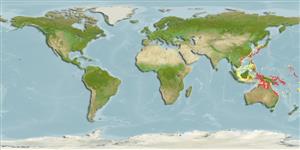>
Eupercaria/misc (Various families in series Eupercaria) >
Lethrinidae (Emperors or scavengers) > Monotaxinae
Etymology: Gymnocranius: Greek, gymnos = naked + Greek, kranion = skull (Ref. 45335); satoi: Named for Torao Sato, a Japanese ichthyologist..
Environment: milieu / climate zone / depth range / distribution range
Ekologi
laut; kisaran kedalaman 20 - 40 m (Ref. 107926). Tropical
Western Pacific: New Caledonia, West Papua (Raja Ampat), southern Japan and possibly Australia (GBR), the Solomon Sea, Bismarck Sea and New Guinea.
Size / Weight / umur
Maturity: Lm ? range ? - ? cm
Max length : 42.2 cm SL jantan/; (Ref. 107926)
deskripsi pendek
Morfologi | Morfometrik
This high-bodied species is distinguished by the following characters: ratio of standard length to body depth between 2.39 and 2.45; bumpy forehead; the lower edge of eye well above axis of body; caudal fin is shallowly forked, the lobes convex on inner side; scale rows above lateral line 6; pored scales on lateral line 47-50; flanks silvery; scales above the lateral line possess a dark-grey basal patch forming longitudinal rows; scales in the three rows below lateral line in middle of flank also forming darker rows, but basal patch not as dark as above lateral line; snout an cheeks with blue speckles against bronze background, distinctive on fresh and larger individuals, but faint on smaller individuals; blue band joining the nostrils on forehead; the area immediately above eye (supraorbital shelf) forming a distinctive brownish to blackish eyebrow; more or less conspicuous vertical dark bar crossing the eye; dorsal, pectoral, anal and caudal fins are reddish to bright vermilion red; upper lip is reddish to red while the lower lip white (Ref. 107926).
This species apparently lives on the coral sandy bottom in the vicinity of coral reefs (Ref. 107926).
Life cycle and mating behavior
Kematangan | Reproduksi, perkembang biakan | Pemijahan | telur-telur | Fecundity | Larva
Borsa, P., P. Béarez, S. Paijo and W.-J. Chen, 2013. Gymnocranius superciliosus and Gymnocranius satoi, two new large-eye breams (Sparoidea: Lethrinidae) from the Coral Sea and adjacent regions. Comptes Rendus Biologies 336: 233-240. (Ref. 107926)
Status IUCN Red List (Ref. 130435)
ancaman kepada manusia
Harmless
penggunaan manusia
informasi lanjut
Nama-nama umumSinonim (persamaan)metabolismePemangsaEkotoksikologiReproduksi, perkembang biakanKematanganPemijahanSpawning aggregationFecunditytelur-telurpekembangan telor
Umur / SaizPertumbuhanpanjang-beratpanjang-panjangukuran frekuensiMorfometrikMorfologiLarvaDinamika larvapemulihanKelimpahanBRUVS
AcuanBudidaya airprofil budidaya airStrainGenetikaElectrophoresesDiturunkanPenyakit-penyakitPengolahanNutrientsMass conversion
mitraGambarStamps, Coins Misc.Suara-suaraCiguateraKecepatanTipe renangArea insangOtolithsOtakPenglihatan / visi
Alat, peralatan
laporan khas
muat turun XML
Sumber internet
Estimates based on models
Phylogenetic diversity index (Ref.
82804): PD
50 = 0.5010 [Uniqueness, from 0.5 = low to 2.0 = high].
Bayesian length-weight: a=0.01778 (0.00761 - 0.04154), b=2.97 (2.78 - 3.16), in cm total length, based on LWR estimates for this (Sub)family-body shape (Ref.
93245).
Trophic level (Ref.
69278): 3.4 ±0.6 se; based on size and trophs of closest relatives
Daya lenting (Ref.
120179): sedang, Waktu penggandaan populasi minimum 1.4 - 4.4 tahun (Preliminary K or Fecundity.).
Fishing Vulnerability (Ref.
59153): Moderate vulnerability (41 of 100).
